Ethical Leadership & E-Governance: Addressing Corruption Risks
VerifiedAdded on 2023/06/03
|9
|1306
|303
Essay
AI Summary
This essay addresses the problem of increasing corruption in e-government due to its interaction with the private sector. It identifies key players like e-government transaction service providers and customers, highlighting challenging factors such as trust, transparency, and cybercrime. The lack of trust arises from risks of data loss and deception, while transparency issues stem from the inconsistent display of statistical data. Cybercrime is presented as a broad category encompassing corruption and fraud. The essay proposes strategic planning, including privacy policies and tracking e-government transactions, as a cooperative approach, alongside transactional leadership to ensure social welfare and ethical technology use. It references various studies to support its arguments, emphasizing the need for anti-corruption initiatives and secured e-governing transactions to build public trust and reduce ethical dilemmas.
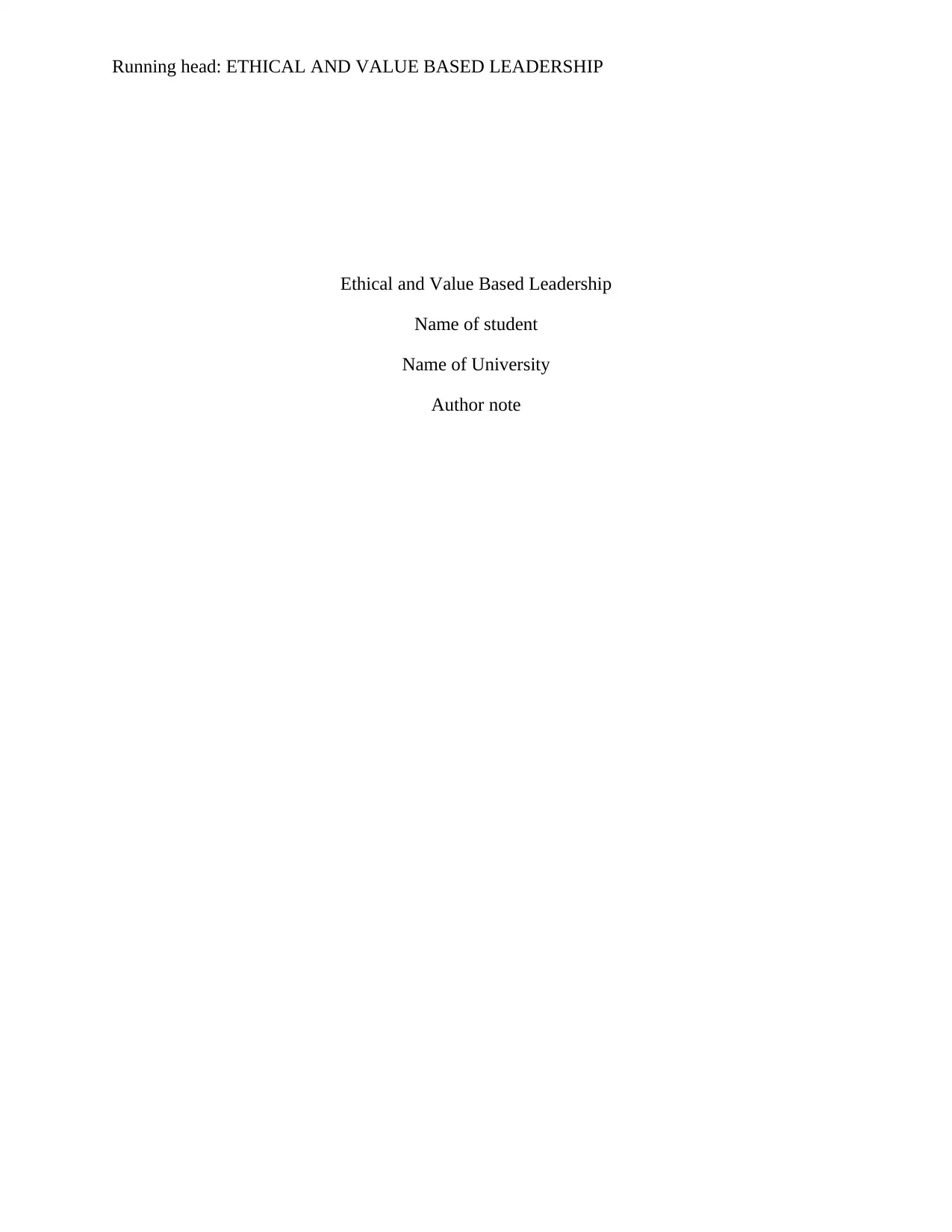
Running head: ETHICAL AND VALUE BASED LEADERSHIP
Ethical and Value Based Leadership
Name of student
Name of University
Author note
Ethical and Value Based Leadership
Name of student
Name of University
Author note
Paraphrase This Document
Need a fresh take? Get an instant paraphrase of this document with our AI Paraphraser
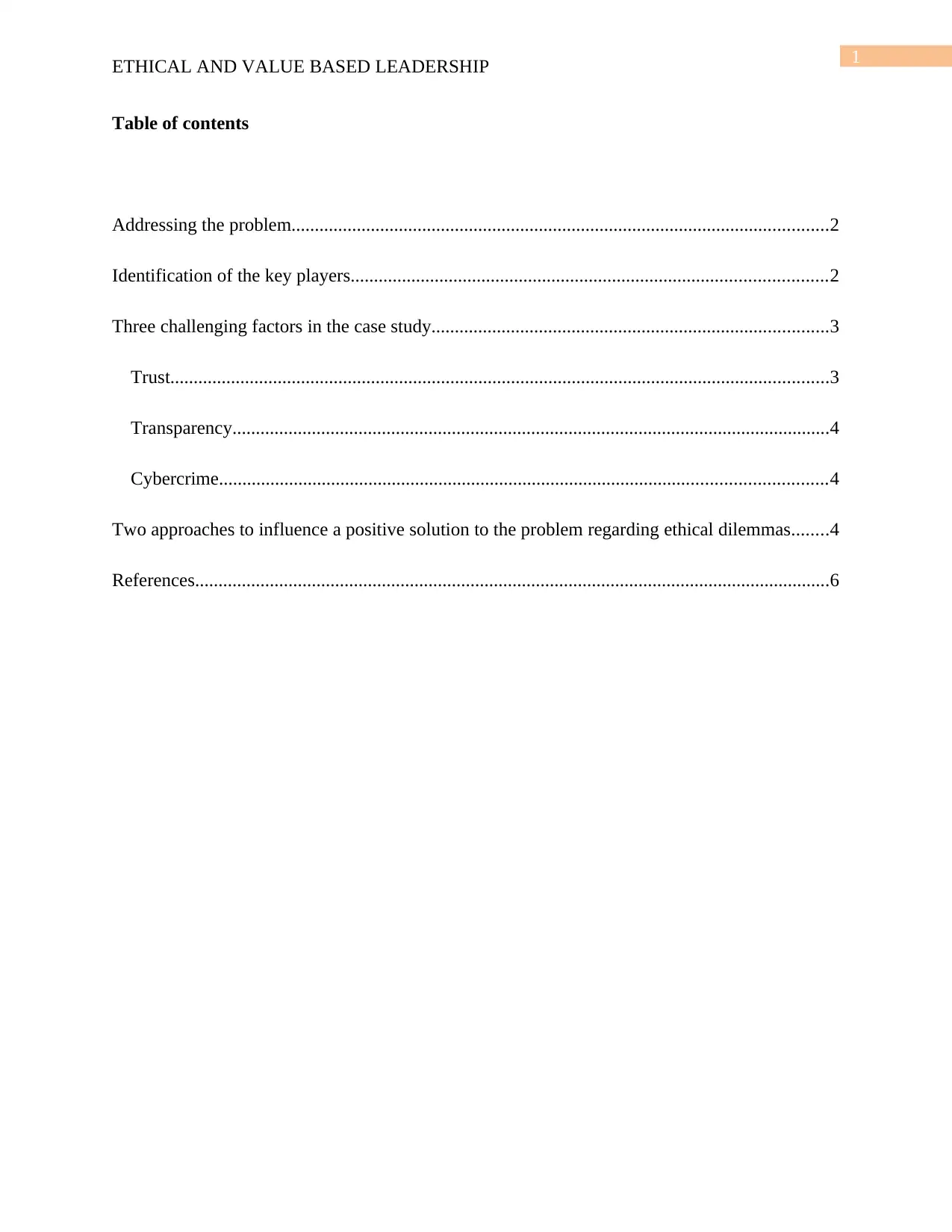
1
ETHICAL AND VALUE BASED LEADERSHIP
Table of contents
Addressing the problem...................................................................................................................2
Identification of the key players......................................................................................................2
Three challenging factors in the case study.....................................................................................3
Trust.............................................................................................................................................3
Transparency................................................................................................................................4
Cybercrime..................................................................................................................................4
Two approaches to influence a positive solution to the problem regarding ethical dilemmas........4
References........................................................................................................................................6
ETHICAL AND VALUE BASED LEADERSHIP
Table of contents
Addressing the problem...................................................................................................................2
Identification of the key players......................................................................................................2
Three challenging factors in the case study.....................................................................................3
Trust.............................................................................................................................................3
Transparency................................................................................................................................4
Cybercrime..................................................................................................................................4
Two approaches to influence a positive solution to the problem regarding ethical dilemmas........4
References........................................................................................................................................6
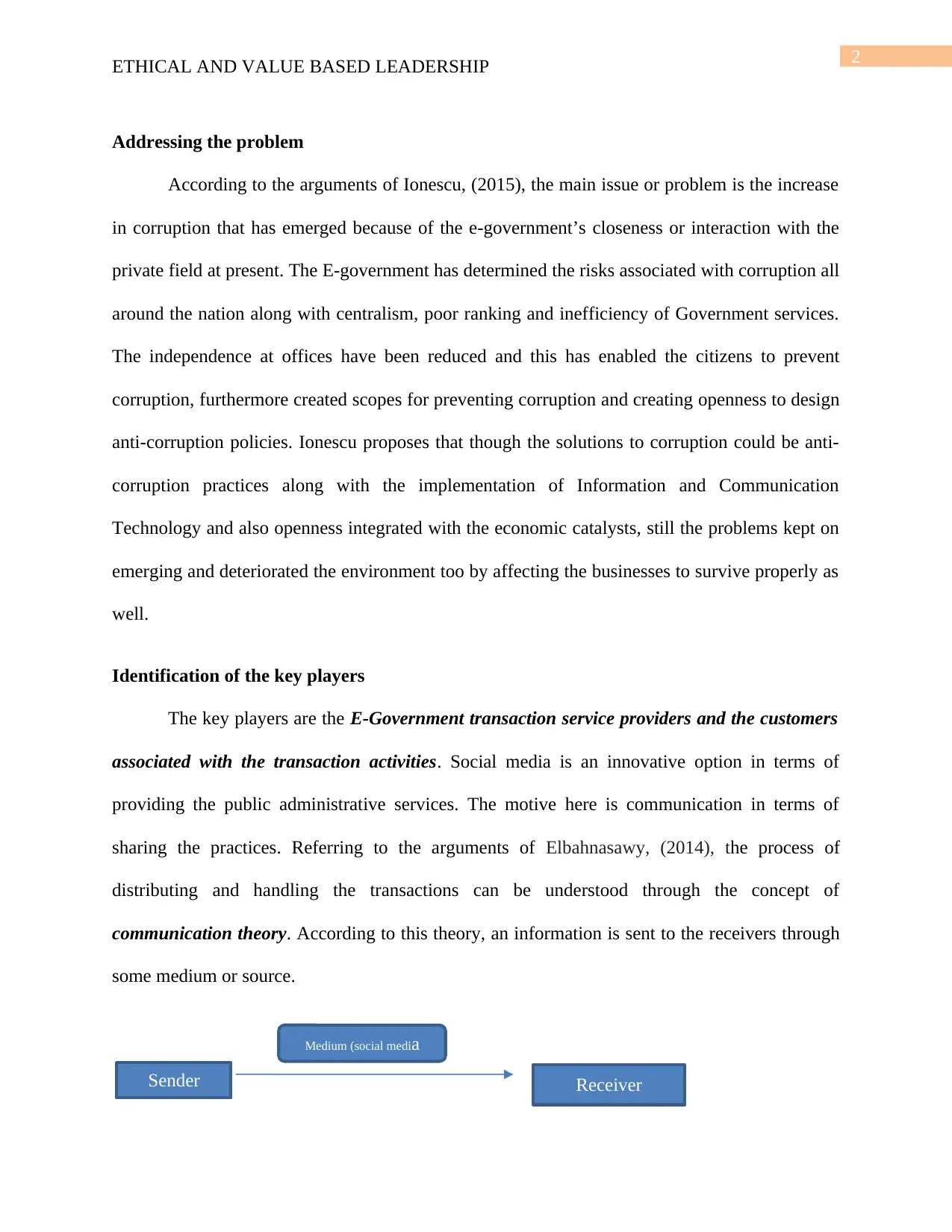
2
ETHICAL AND VALUE BASED LEADERSHIP
Addressing the problem
According to the arguments of Ionescu, (2015), the main issue or problem is the increase
in corruption that has emerged because of the e-government’s closeness or interaction with the
private field at present. The E-government has determined the risks associated with corruption all
around the nation along with centralism, poor ranking and inefficiency of Government services.
The independence at offices have been reduced and this has enabled the citizens to prevent
corruption, furthermore created scopes for preventing corruption and creating openness to design
anti-corruption policies. Ionescu proposes that though the solutions to corruption could be anti-
corruption practices along with the implementation of Information and Communication
Technology and also openness integrated with the economic catalysts, still the problems kept on
emerging and deteriorated the environment too by affecting the businesses to survive properly as
well.
Identification of the key players
The key players are the E-Government transaction service providers and the customers
associated with the transaction activities. Social media is an innovative option in terms of
providing the public administrative services. The motive here is communication in terms of
sharing the practices. Referring to the arguments of Elbahnasawy, (2014), the process of
distributing and handling the transactions can be understood through the concept of
communication theory. According to this theory, an information is sent to the receivers through
some medium or source.
Sender Receiver
Medium (social media
ETHICAL AND VALUE BASED LEADERSHIP
Addressing the problem
According to the arguments of Ionescu, (2015), the main issue or problem is the increase
in corruption that has emerged because of the e-government’s closeness or interaction with the
private field at present. The E-government has determined the risks associated with corruption all
around the nation along with centralism, poor ranking and inefficiency of Government services.
The independence at offices have been reduced and this has enabled the citizens to prevent
corruption, furthermore created scopes for preventing corruption and creating openness to design
anti-corruption policies. Ionescu proposes that though the solutions to corruption could be anti-
corruption practices along with the implementation of Information and Communication
Technology and also openness integrated with the economic catalysts, still the problems kept on
emerging and deteriorated the environment too by affecting the businesses to survive properly as
well.
Identification of the key players
The key players are the E-Government transaction service providers and the customers
associated with the transaction activities. Social media is an innovative option in terms of
providing the public administrative services. The motive here is communication in terms of
sharing the practices. Referring to the arguments of Elbahnasawy, (2014), the process of
distributing and handling the transactions can be understood through the concept of
communication theory. According to this theory, an information is sent to the receivers through
some medium or source.
Sender Receiver
Medium (social media
⊘ This is a preview!⊘
Do you want full access?
Subscribe today to unlock all pages.

Trusted by 1+ million students worldwide
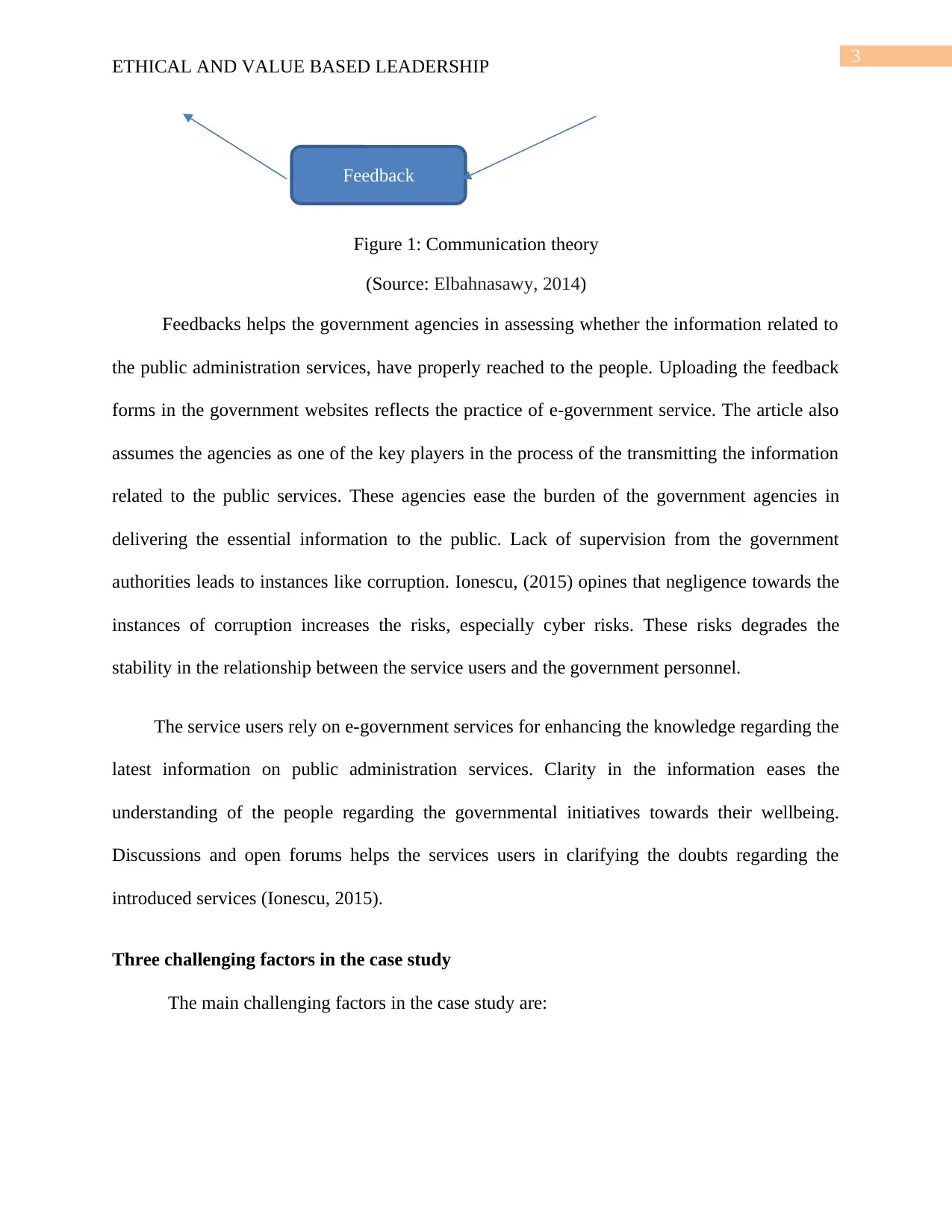
3
ETHICAL AND VALUE BASED LEADERSHIP
Figure 1: Communication theory
(Source: Elbahnasawy, 2014)
Feedbacks helps the government agencies in assessing whether the information related to
the public administration services, have properly reached to the people. Uploading the feedback
forms in the government websites reflects the practice of e-government service. The article also
assumes the agencies as one of the key players in the process of the transmitting the information
related to the public services. These agencies ease the burden of the government agencies in
delivering the essential information to the public. Lack of supervision from the government
authorities leads to instances like corruption. Ionescu, (2015) opines that negligence towards the
instances of corruption increases the risks, especially cyber risks. These risks degrades the
stability in the relationship between the service users and the government personnel.
The service users rely on e-government services for enhancing the knowledge regarding the
latest information on public administration services. Clarity in the information eases the
understanding of the people regarding the governmental initiatives towards their wellbeing.
Discussions and open forums helps the services users in clarifying the doubts regarding the
introduced services (Ionescu, 2015).
Three challenging factors in the case study
The main challenging factors in the case study are:
Feedback
ETHICAL AND VALUE BASED LEADERSHIP
Figure 1: Communication theory
(Source: Elbahnasawy, 2014)
Feedbacks helps the government agencies in assessing whether the information related to
the public administration services, have properly reached to the people. Uploading the feedback
forms in the government websites reflects the practice of e-government service. The article also
assumes the agencies as one of the key players in the process of the transmitting the information
related to the public services. These agencies ease the burden of the government agencies in
delivering the essential information to the public. Lack of supervision from the government
authorities leads to instances like corruption. Ionescu, (2015) opines that negligence towards the
instances of corruption increases the risks, especially cyber risks. These risks degrades the
stability in the relationship between the service users and the government personnel.
The service users rely on e-government services for enhancing the knowledge regarding the
latest information on public administration services. Clarity in the information eases the
understanding of the people regarding the governmental initiatives towards their wellbeing.
Discussions and open forums helps the services users in clarifying the doubts regarding the
introduced services (Ionescu, 2015).
Three challenging factors in the case study
The main challenging factors in the case study are:
Feedback
Paraphrase This Document
Need a fresh take? Get an instant paraphrase of this document with our AI Paraphraser
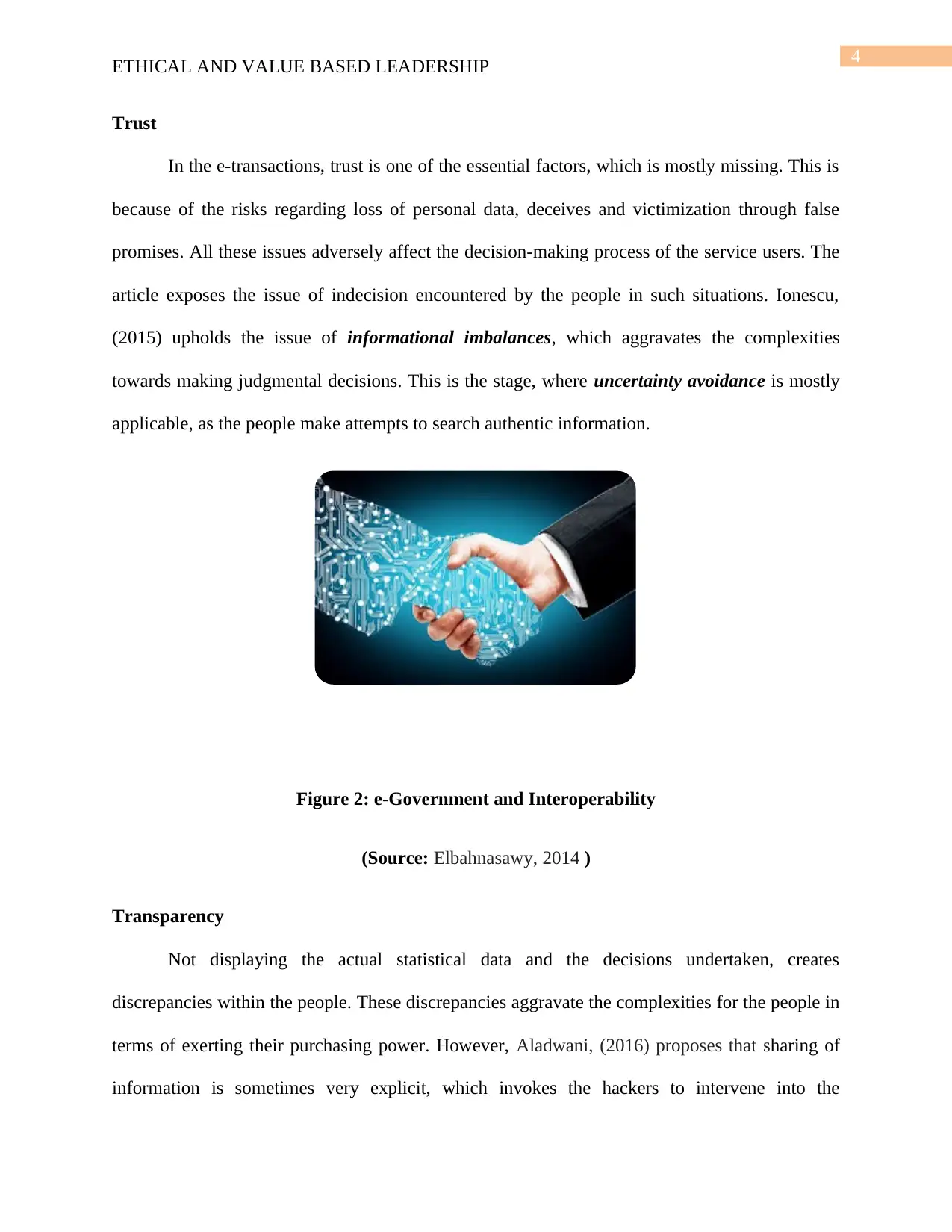
4
ETHICAL AND VALUE BASED LEADERSHIP
Trust
In the e-transactions, trust is one of the essential factors, which is mostly missing. This is
because of the risks regarding loss of personal data, deceives and victimization through false
promises. All these issues adversely affect the decision-making process of the service users. The
article exposes the issue of indecision encountered by the people in such situations. Ionescu,
(2015) upholds the issue of informational imbalances, which aggravates the complexities
towards making judgmental decisions. This is the stage, where uncertainty avoidance is mostly
applicable, as the people make attempts to search authentic information.
Figure 2: e-Government and Interoperability
(Source: Elbahnasawy, 2014 )
Transparency
Not displaying the actual statistical data and the decisions undertaken, creates
discrepancies within the people. These discrepancies aggravate the complexities for the people in
terms of exerting their purchasing power. However, Aladwani, (2016) proposes that sharing of
information is sometimes very explicit, which invokes the hackers to intervene into the
ETHICAL AND VALUE BASED LEADERSHIP
Trust
In the e-transactions, trust is one of the essential factors, which is mostly missing. This is
because of the risks regarding loss of personal data, deceives and victimization through false
promises. All these issues adversely affect the decision-making process of the service users. The
article exposes the issue of indecision encountered by the people in such situations. Ionescu,
(2015) upholds the issue of informational imbalances, which aggravates the complexities
towards making judgmental decisions. This is the stage, where uncertainty avoidance is mostly
applicable, as the people make attempts to search authentic information.
Figure 2: e-Government and Interoperability
(Source: Elbahnasawy, 2014 )
Transparency
Not displaying the actual statistical data and the decisions undertaken, creates
discrepancies within the people. These discrepancies aggravate the complexities for the people in
terms of exerting their purchasing power. However, Aladwani, (2016) proposes that sharing of
information is sometimes very explicit, which invokes the hackers to intervene into the
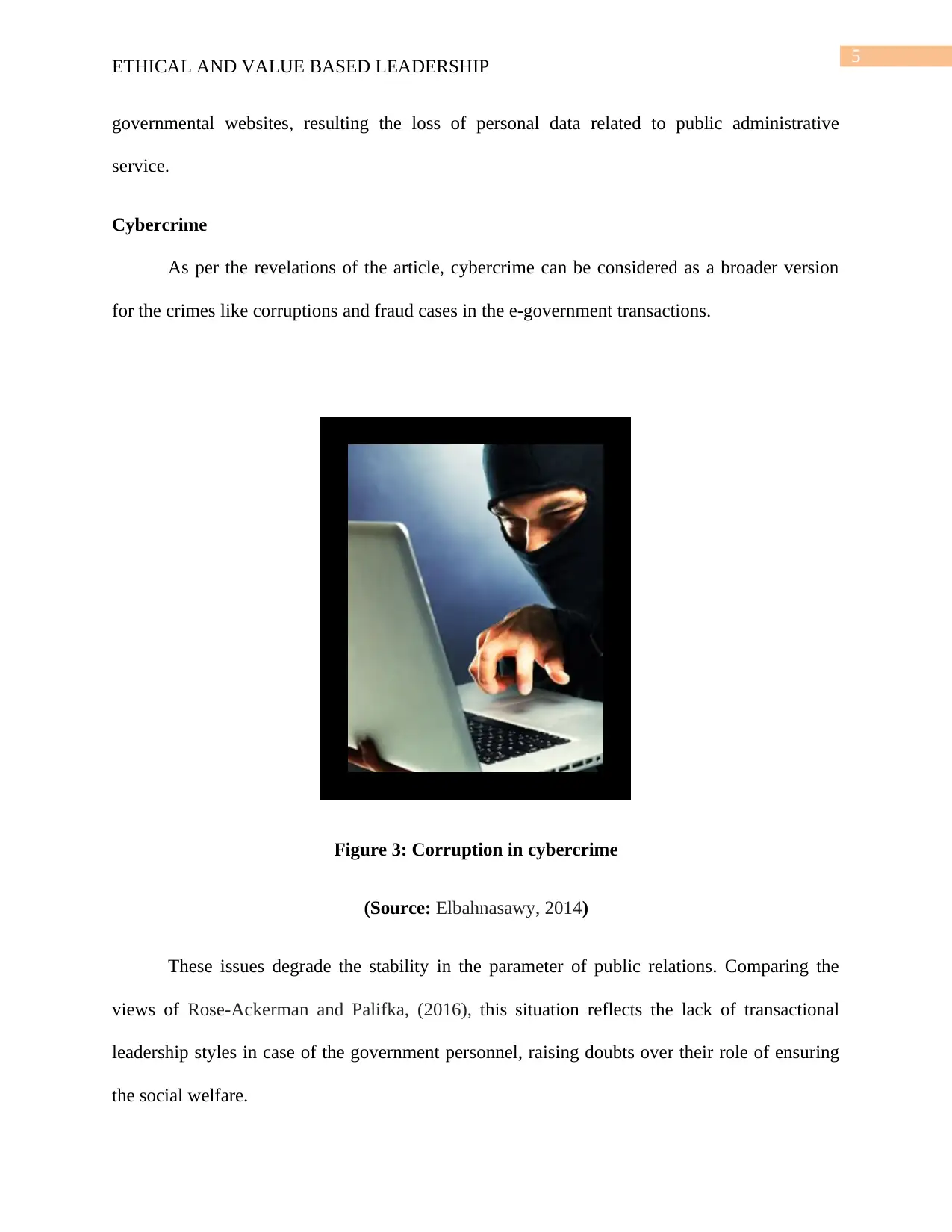
5
ETHICAL AND VALUE BASED LEADERSHIP
governmental websites, resulting the loss of personal data related to public administrative
service.
Cybercrime
As per the revelations of the article, cybercrime can be considered as a broader version
for the crimes like corruptions and fraud cases in the e-government transactions.
Figure 3: Corruption in cybercrime
(Source: Elbahnasawy, 2014)
These issues degrade the stability in the parameter of public relations. Comparing the
views of Rose-Ackerman and Palifka, (2016), this situation reflects the lack of transactional
leadership styles in case of the government personnel, raising doubts over their role of ensuring
the social welfare.
ETHICAL AND VALUE BASED LEADERSHIP
governmental websites, resulting the loss of personal data related to public administrative
service.
Cybercrime
As per the revelations of the article, cybercrime can be considered as a broader version
for the crimes like corruptions and fraud cases in the e-government transactions.
Figure 3: Corruption in cybercrime
(Source: Elbahnasawy, 2014)
These issues degrade the stability in the parameter of public relations. Comparing the
views of Rose-Ackerman and Palifka, (2016), this situation reflects the lack of transactional
leadership styles in case of the government personnel, raising doubts over their role of ensuring
the social welfare.
⊘ This is a preview!⊘
Do you want full access?
Subscribe today to unlock all pages.

Trusted by 1+ million students worldwide
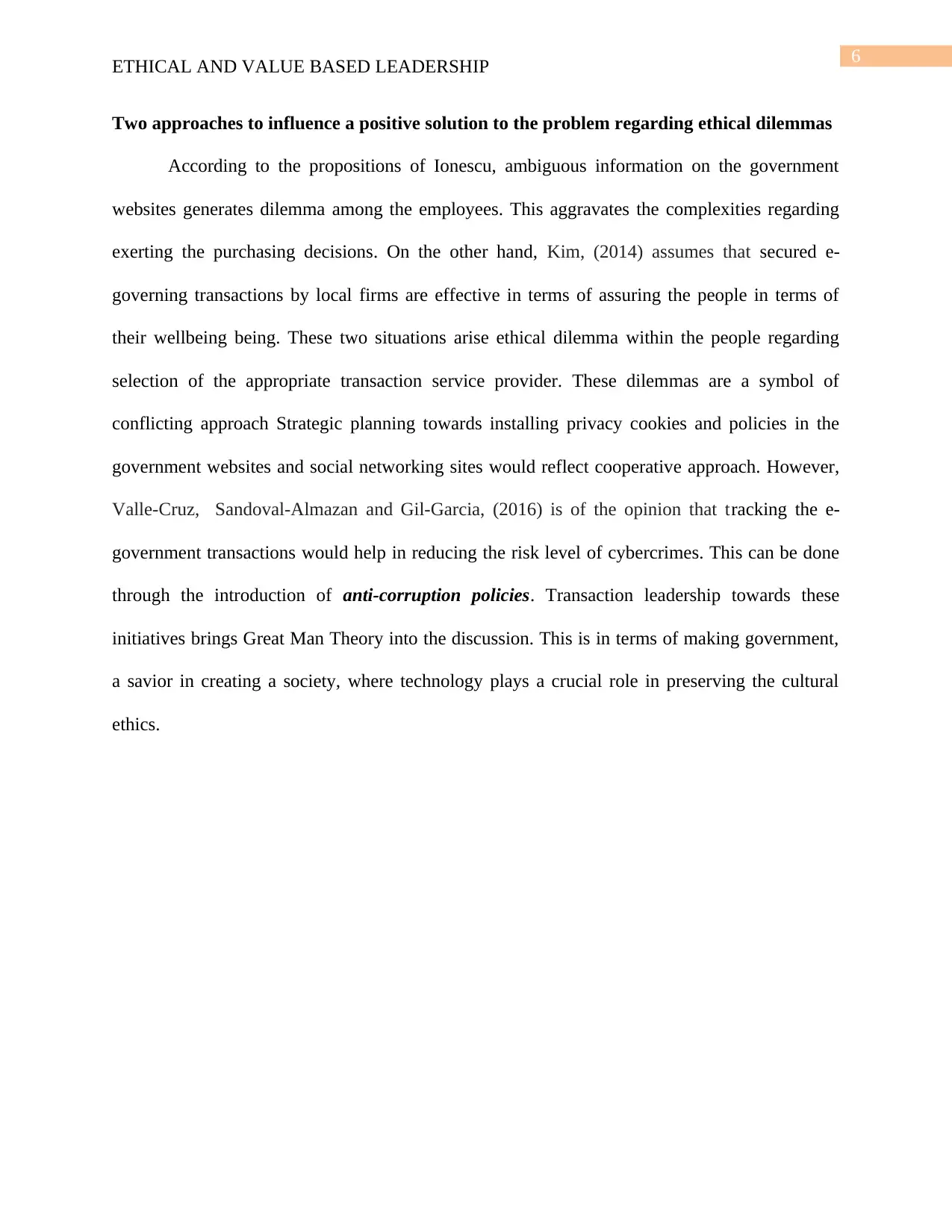
6
ETHICAL AND VALUE BASED LEADERSHIP
Two approaches to influence a positive solution to the problem regarding ethical dilemmas
According to the propositions of Ionescu, ambiguous information on the government
websites generates dilemma among the employees. This aggravates the complexities regarding
exerting the purchasing decisions. On the other hand, Kim, (2014) assumes that secured e-
governing transactions by local firms are effective in terms of assuring the people in terms of
their wellbeing being. These two situations arise ethical dilemma within the people regarding
selection of the appropriate transaction service provider. These dilemmas are a symbol of
conflicting approach Strategic planning towards installing privacy cookies and policies in the
government websites and social networking sites would reflect cooperative approach. However,
Valle-Cruz, Sandoval-Almazan and Gil-Garcia, (2016) is of the opinion that tracking the e-
government transactions would help in reducing the risk level of cybercrimes. This can be done
through the introduction of anti-corruption policies. Transaction leadership towards these
initiatives brings Great Man Theory into the discussion. This is in terms of making government,
a savior in creating a society, where technology plays a crucial role in preserving the cultural
ethics.
ETHICAL AND VALUE BASED LEADERSHIP
Two approaches to influence a positive solution to the problem regarding ethical dilemmas
According to the propositions of Ionescu, ambiguous information on the government
websites generates dilemma among the employees. This aggravates the complexities regarding
exerting the purchasing decisions. On the other hand, Kim, (2014) assumes that secured e-
governing transactions by local firms are effective in terms of assuring the people in terms of
their wellbeing being. These two situations arise ethical dilemma within the people regarding
selection of the appropriate transaction service provider. These dilemmas are a symbol of
conflicting approach Strategic planning towards installing privacy cookies and policies in the
government websites and social networking sites would reflect cooperative approach. However,
Valle-Cruz, Sandoval-Almazan and Gil-Garcia, (2016) is of the opinion that tracking the e-
government transactions would help in reducing the risk level of cybercrimes. This can be done
through the introduction of anti-corruption policies. Transaction leadership towards these
initiatives brings Great Man Theory into the discussion. This is in terms of making government,
a savior in creating a society, where technology plays a crucial role in preserving the cultural
ethics.
Paraphrase This Document
Need a fresh take? Get an instant paraphrase of this document with our AI Paraphraser
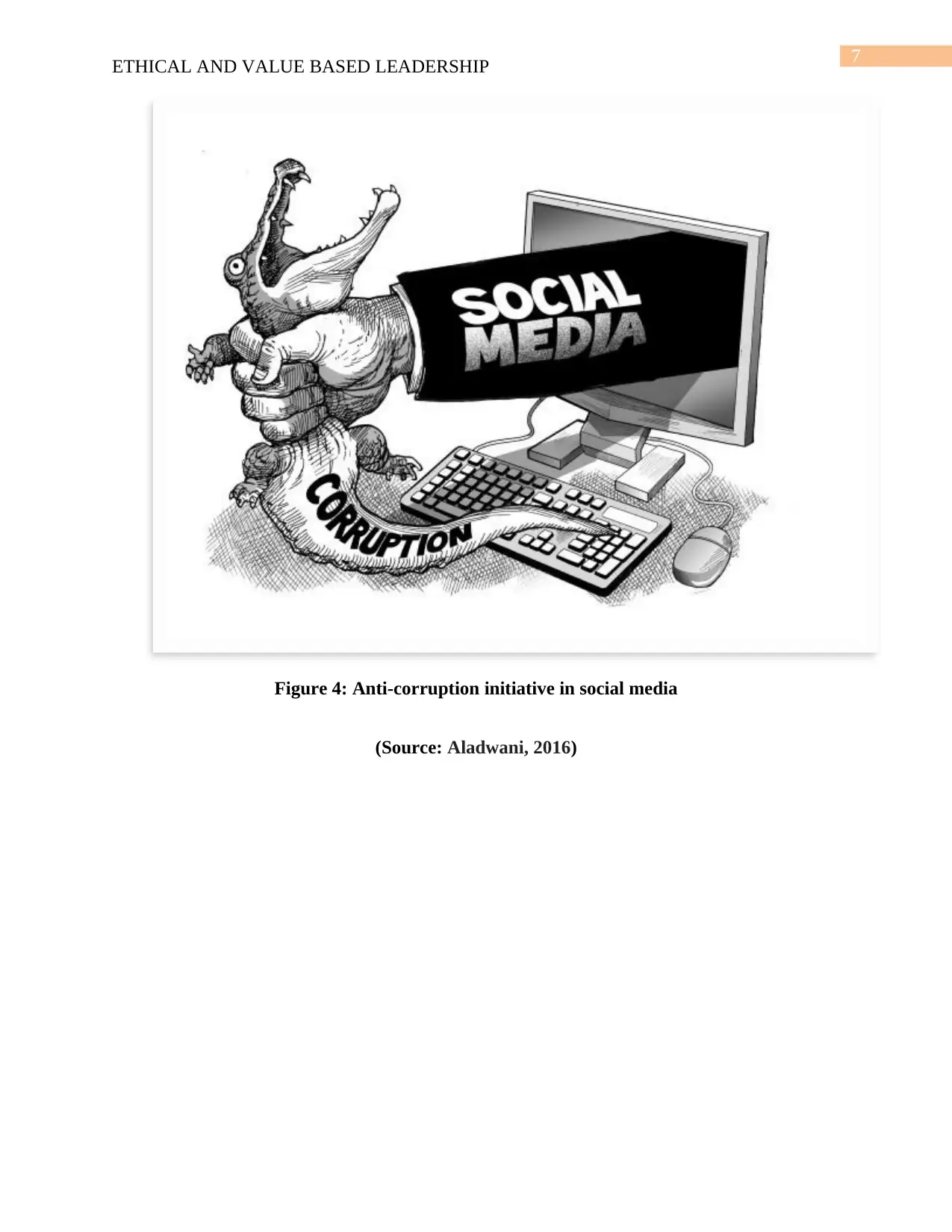
7
ETHICAL AND VALUE BASED LEADERSHIP
Figure 4: Anti-corruption initiative in social media
(Source: Aladwani, 2016)
ETHICAL AND VALUE BASED LEADERSHIP
Figure 4: Anti-corruption initiative in social media
(Source: Aladwani, 2016)
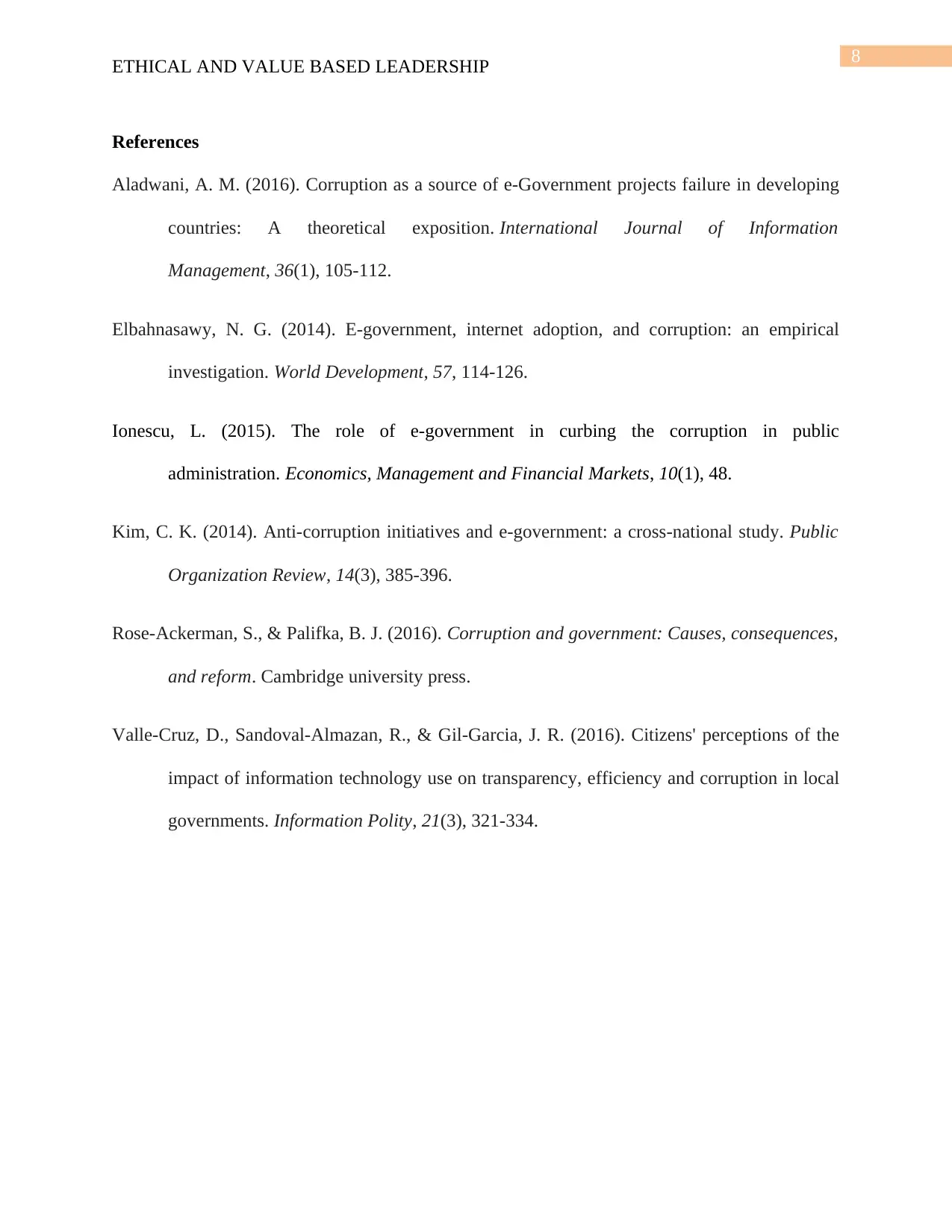
8
ETHICAL AND VALUE BASED LEADERSHIP
References
Aladwani, A. M. (2016). Corruption as a source of e-Government projects failure in developing
countries: A theoretical exposition. International Journal of Information
Management, 36(1), 105-112.
Elbahnasawy, N. G. (2014). E-government, internet adoption, and corruption: an empirical
investigation. World Development, 57, 114-126.
Ionescu, L. (2015). The role of e-government in curbing the corruption in public
administration. Economics, Management and Financial Markets, 10(1), 48.
Kim, C. K. (2014). Anti-corruption initiatives and e-government: a cross-national study. Public
Organization Review, 14(3), 385-396.
Rose-Ackerman, S., & Palifka, B. J. (2016). Corruption and government: Causes, consequences,
and reform. Cambridge university press.
Valle-Cruz, D., Sandoval-Almazan, R., & Gil-Garcia, J. R. (2016). Citizens' perceptions of the
impact of information technology use on transparency, efficiency and corruption in local
governments. Information Polity, 21(3), 321-334.
ETHICAL AND VALUE BASED LEADERSHIP
References
Aladwani, A. M. (2016). Corruption as a source of e-Government projects failure in developing
countries: A theoretical exposition. International Journal of Information
Management, 36(1), 105-112.
Elbahnasawy, N. G. (2014). E-government, internet adoption, and corruption: an empirical
investigation. World Development, 57, 114-126.
Ionescu, L. (2015). The role of e-government in curbing the corruption in public
administration. Economics, Management and Financial Markets, 10(1), 48.
Kim, C. K. (2014). Anti-corruption initiatives and e-government: a cross-national study. Public
Organization Review, 14(3), 385-396.
Rose-Ackerman, S., & Palifka, B. J. (2016). Corruption and government: Causes, consequences,
and reform. Cambridge university press.
Valle-Cruz, D., Sandoval-Almazan, R., & Gil-Garcia, J. R. (2016). Citizens' perceptions of the
impact of information technology use on transparency, efficiency and corruption in local
governments. Information Polity, 21(3), 321-334.
⊘ This is a preview!⊘
Do you want full access?
Subscribe today to unlock all pages.

Trusted by 1+ million students worldwide
1 out of 9
Related Documents
Your All-in-One AI-Powered Toolkit for Academic Success.
+13062052269
info@desklib.com
Available 24*7 on WhatsApp / Email
![[object Object]](/_next/static/media/star-bottom.7253800d.svg)
Unlock your academic potential
Copyright © 2020–2025 A2Z Services. All Rights Reserved. Developed and managed by ZUCOL.





